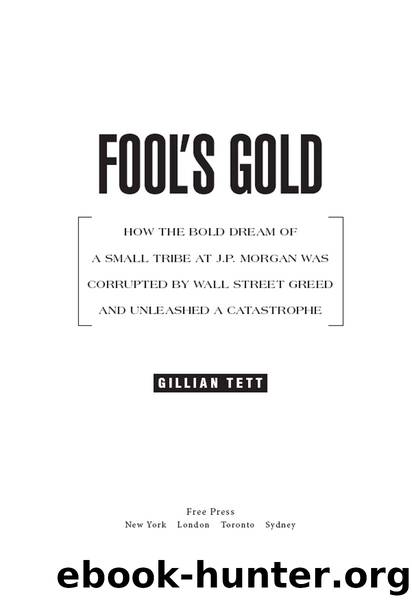Fool's Gold: How the Bold Dream of a Small Tribe at J.P. Morgan Was Corrupted by Wall Street Greed and Unleashed a Catastrophe by Gillian Tett

Author:Gillian Tett [Tett, Gillian]
Language: eng
Format: azw3
Publisher: Free Press
Published: 2009-06-09T04:00:00+00:00
By mid-2006, the pressure on Bill Winters’s team to make up ground on its rivals was intense. Each year, Oliver Wyman, a consultancy group, conducted an analysis of how all the banks were faring relative to each other. The consultancy would then release the results to the banks, in the hope that doing so would prompt them to buy Wyman’s services. J.P. Morgan did not usually succumb to that marketing pitch. When Dimon took over the bank, he had made it clear that he hated the idea of taking advice from management consultants. “Those consultants are a crock of shit!” he sometimes told his staff. To his mind, if a banker needed to take advice from consultants, then that banker was not doing his or her job.
However, the top managers at J.P. Morgan found that the reports often provided useful comparative intelligence. Blythe Masters had particular reason to pay attention to what Oliver Wyman said. By that stage, Masters had moved a long way from the credit derivatives team. After the JPMorgan Chase merger, she had been one of the few members of that group who had the patience and political skills to survive the infighting. She rocketed up the corporate hierarchy, being appointed chief financial officer of the investment bank in 2005, at the age of just thirty-four. It was a striking achievement, making her one of the most senior women on Wall Street. By 2005, some of her colleagues were whispering that Masters might possibly be heading for the very top.
As CFO, Masters was responsible for tracking how J.P. Morgan was faring relative to rivals and presenting that to outside analysts. So in the spring of 2006, she met with Nick Studer, one of the consultants at Oliver Wyman, to discuss Wyman’s “gap analysis” on how JPMorgan Chase had fared in 2005. This report essentially asked a clutch of banks to submit data on how their different divisions were performing, which the consultants then used to calculate how the banks looked relative to each other (on an anonymous basis). The 2005 scorecard made dismal reading for JPMorgan Chase. The bank was performing well in some areas, such as foreign exchange or interest-rate derivatives. However, in securitization, the bank’s underperformance was getting worse. Equities and commodities were weak, too. As a result, the total revenue gap between JPMorgan Chase’s investment bank and that of its rivals had surged to around $1.5 billion.
More than a billion dollars! Masters was startled and baffled. She knew that it would not be easy to placate equity investors in the bank’s stock if they saw that. The year 2005 had been another record year for the banking world, with the largest investment banks collectively raising their revenues by 31 percent to $289 billion. In that time, however, JPMorgan Chase had produced only a modest rise. So what should the bank do? Was it time for the bank to revisit, once again, getting into the mortgage CDO and CDS game?
Once again, Winters asked his team
Download
This site does not store any files on its server. We only index and link to content provided by other sites. Please contact the content providers to delete copyright contents if any and email us, we'll remove relevant links or contents immediately.
International Integration of the Brazilian Economy by Elias C. Grivoyannis(74711)
The Radium Girls by Kate Moore(11621)
Turbulence by E. J. Noyes(7700)
Nudge - Improving Decisions about Health, Wealth, and Happiness by Thaler Sunstein(7242)
The Black Swan by Nassim Nicholas Taleb(6763)
Rich Dad Poor Dad by Robert T. Kiyosaki(6174)
Pioneering Portfolio Management by David F. Swensen(6078)
Man-made Catastrophes and Risk Information Concealment by Dmitry Chernov & Didier Sornette(5646)
Zero to One by Peter Thiel(5488)
Secrecy World by Jake Bernstein(4388)
Millionaire: The Philanderer, Gambler, and Duelist Who Invented Modern Finance by Janet Gleeson(4093)
The Age of Surveillance Capitalism by Shoshana Zuboff(3983)
Skin in the Game by Nassim Nicholas Taleb(3965)
The Money Culture by Michael Lewis(3846)
Bullshit Jobs by David Graeber(3828)
Skin in the Game: Hidden Asymmetries in Daily Life by Nassim Nicholas Taleb(3722)
The Dhandho Investor by Mohnish Pabrai(3560)
The Wisdom of Finance by Mihir Desai(3523)
Blockchain Basics by Daniel Drescher(3329)
